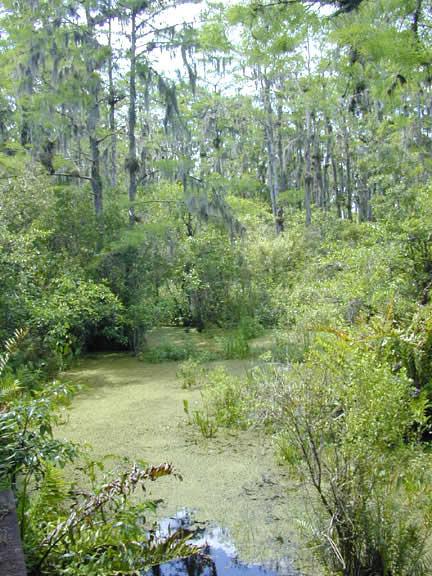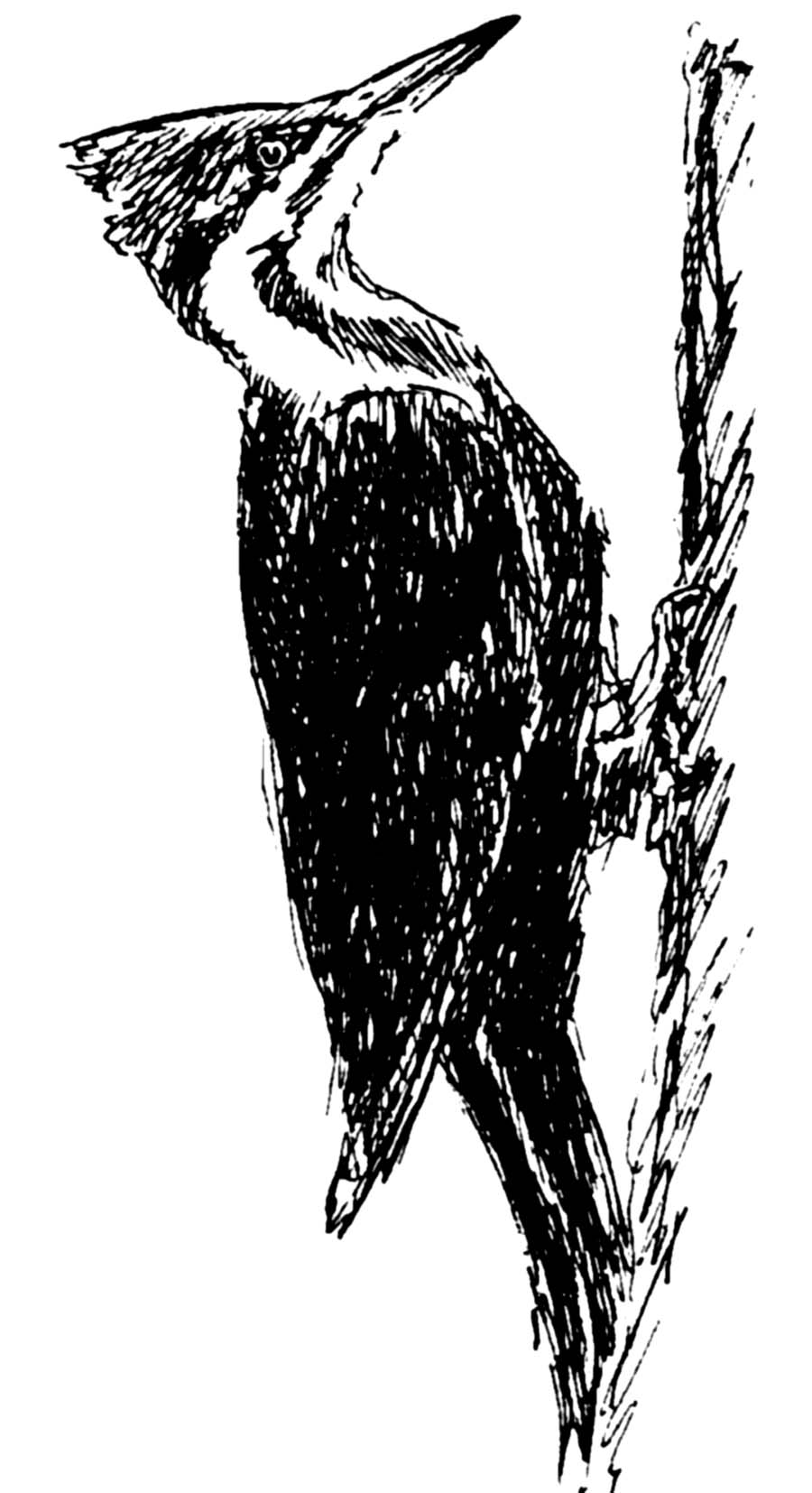STORY LINKS
Front Page
Wright is Wrong
Mystery Airship
Killer Cougars
Giant Rabbits
Michigan Caves?
Islands from Space!
Flying Squirrels
Bogus Archeology
Gold in the River!
Michigan's Cactus
Foolish Fire
Pileated Woodpecker
Questions, comments, submissions, & advertising
Contact BPP
|

 Michigan Chronoscope - Stories on the fringe of history
Michigan Chronoscope - Stories on the fringe of history
Chronograph Numeral I - Autumn 2004 - Page Seven
|
Fool's Fire
 Freshwater Swamp in Florida
Freshwater Swamp in Florida
It was a long hot summer's day and finally, a cool evening breeze puts you in the mood for a walk in the woods. You head out to some piece of public forest and go on your walk. After a while, you're deep in the woods, far from the main trail and you're not quite sure where you parked. Asking yourself "Why didn't I take a compass?" and finding it hard to judge where the sun went down, you begin to panic. As the woods darken, it's just your luck there's no moon to guide your way, but you swear this is the right trail and the direction back to the safety of your vehicle. Then not too far in the distance you see lights and believe it must be flashlights or lanterns, either way, you're sure to find some help.
You walk faster toward the lights that flicker and seem to move away from you as you approach them. You increase your pace, dodging the barely visible shadows that are all you can see of the trees. You're no longer on any trail and your muddy, soaking shoes tell you you're in a swamp, but you reason that it must be raccoon hunters with flashlights just a little further ahead. You start yelling 'Hey! I'm lost back here, can you help me out!' when you trip over a log and land in a deep swampy pool. The water is up to your waist and filled with deep muck that gives you little footing. You feel tree roots that give you some leverage on one foot, but your next step breaks through the root tangle. You're now up to your neck in rancid swamp water and sinking fast. Your last feeble cries are unanswered by the ghostly lights as you become a victim of the Will-O-Wisp.
Although explained by folklore in different ways and called by different names, like St. Elmo's Fire or Jack-O-Lantern, Fool's Fire always leads the unwary to their doom at night in some deep swamp or bog. These phantom lights are claimed to be paranormal events related to malicious fairies, lost souls, and UFOs, while more conservative beliefs claim they are related to seismic activity, ball lightning, swamp gas, or glowing fungus. I tend toward only two of the more conservative beliefs that these mysterious lights are caused by seismic activity or bioluminescent fungus.
Swamp gas or ball lightning is a highly unlikely explanation for the Will-O-Wisp phenomenon. Ball lightning would be a good explanation if electrical storms were always connected to the ghost light sightings. The chance of decaying material in a swamp generating enough heat to ignite the methane of the swamp gas is nearly impossible. At around 130 degrees F, microorganisms responsible for organic decay begin to die off and cease producing heat and methane (methane production occurs best at around 90 to 95 degrees F). Methane approaches a combustion temperature in the air of 3,272 degrees F.
Because ghost lights are often seen repeatedly in areas of active fault lines and have been well documented as being seen on and over mountains, the seismic explanation fits well for such areas. One small problem with this theory is that there are no swamps on the sides or tops of mountains. Swamps and bogs are where the lights always seem to lead people in the legends, so the only other explanation would be glowing fungus.
Glowing fungus sounds like something from 'A Journey to the Center of the Earth' but we have it here in Michigan and it is often called 'Foxfire'. The most common fungus responsible for foxfire is Armillaria mellea, or Honey Mushroom. This poisonous fungus is usually found in rich soil or on decaying logs in forests and swamps. There is another common glowing fungus Omphalotus olerius, or the Jack-O-Lantern mushroom. Foxfire glows from the fuzzy fibers (mycelium) of the underground portion of the plant and Jack-O-Lanterns glow from the gills of its mushroom.
Still, the glowing fungus theory doesn't explain how the lights seem to move away as you chase them or how they flicker and change intensity. Glowing mushrooms aren't going to move or blink, they'll just sit there. One explanation not yet addressed is the idea that reflected lights in a dark environment may fool a person into believing they have the characteristics described earlier. A pool of swamp water reflecting moonlight may seem to move in relation to a person's movements. A reflected light will seem to disappear when approached due to the change in the angle of reflection, and another further away may seem to appear. A panic-stricken person, lost at night in the woods, may be disoriented enough to believe reflections to be source lights. Stumbling around lost in a swamp at night can very often lead someone to a tragic and unknown end. Such mysterious missing person cases often lead to less than reasonable explanations and very often superstitions and myths are used to fill in the blanks.
Comment about this article on the
Epress Forum Board
.
|
|
Pileated Woodpecker
 Largest Woodpecker in Michigan
Largest Woodpecker in Michigan
This shy bird of mature forests is the second largest of the woodpecker family, only the Imperial Woodpecker of western Mexico is larger. Around 20" long with a 30" wingspan, this bird is much larger than the flicker or other smaller woodpeckers. Along with its impressive size and large crest of red crown feathers, is its loud call, a "cuk-cuk-cuk-cuk-cuk" sound that rises and falls in pitch. Its call sounds like that of some exotic tropical bird lost in our northern forests. The only larger woodpecker in the U.S. and a close relative of the pileated woodpecker is the ivory-billed woodpecker from the bayous of Louisiana which is thought to be extinct.
There is a pair of these large noisy woodpeckers around in my woods and they are indeed quite shy. After seeing this woodpecker at fairly close range, I'd say that it was the inspiration for Walter Lance's "Woody Woodpecker" character. Its large, heavy beak can really tear into a tree, but it isn't quite as formidable as Woody's speed and power and it wouldn't likely pulverize your house or all your wooden furniture.
The pileated woodpecker was once on the endangered species list but is now doing fairly well as long as it has open forests with big, old pine trees. Periodic fire is needed to control the brushy understory and keep the pinewoods open to create the best habitat for this woodpecker. Controlled burns are the main reason this bird has become more widespread and is no longer given the status of endangered.
Pileated Woodpeckers nest in cavities of live pine trees. Cavities are built only in large, old pines. The birds peck the bark around the entrance to get the sap flowing around the hole. The sticky sap keeps predators like snakes away from the nest cavity.
This woodpecker feeds on insects, primarily carpenter ants and woodboring beetle larvae. It pries off long slivers of wood to expose ant galleries. The Pileated Woodpecker uses its long, barbed, and sticky tongue to extract ants and other insects from their tunnels. The pileated woodpecker may play an important role in controlling insect outbreaks, particularly those of tree beetles. Also, this woodpecker's nest excavations provide habitat for many other species.
Comment about this article on the
Epress Forum Board
.

|
|
|
Keywords: Michigan, Great Lakes, history, amazing, astonishing, baffling, bizarre, cryptic, curious, different, extraordinary, forgotten, hidden, incredible, inexplicable, legends, lore, lost, myths, obscure, odd, peculiar, rare, stories, strange, surprising, tales, unexplained, unfamiliar, unique, unknown, unusual, weird
|
|



